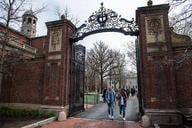You have /5 articles left.
Sign up for a free account or log in.
After years of declining enrollments, American medical schools experienced a surge of new students this year to form the largest incoming class on record. That development was neither unplanned nor unwelcome; the schools’ main advocacy group, the Association of American Medical Colleges, called for a 30-percent boost last year amid reports — not uncontested — that the United States would otherwise face a serious shortage of doctors.
That strategy seems to have worked: Medical schools are admitting more students than ever while the number of applications continues to rise. But even if the enrollment jump (2.3 percent) wasn’t a surprise to officials at the institutions, it does present an entirely new set of problems as they prepare to absorb the projected increase by 2015, as the association advocates. Deans and other senior administrators from schools that have been planning for expanded incoming classes discussed some of the issues they’ve had to face at an afternoon session on Monday of the AAMC’s annual conference in Washington.
The session, “The Expanding Class Size,” featured a colorful array of participants, including an energetic (and enrollment-themed) send-up of Gilbert and Sullivan’s “Major-General’s Song” from The Pirates of Penzance — a gambit that seemed to have roused the audience enough from its inevitable post-lunch slump to offer an enthusiastic round of applause.
“Expansion is a big strategic initiative; it has many moving parts,” said William Mallon, a scholar at the AAMC whose interests (besides comic operas) include leadership and faculty issues at medical schools.
Speakers outlined their own institutions’ approaches, from increasing individual class sizes to adding new campuses to creating entirely new schools. Mallon’s song summarized, in under four minutes, the preliminary findings of the 2006 AAMC Center for Workforce Studies’ survey of medical school expansion plans, which will be released in full in late December or early January. According to the survey, the planned first-year enrollment increase by the 2011-12 school year was 678, or 10.7 percent of the 2002-03 baseline, for private institutions and 1,880, or 19.3 of the baseline, for public ones.
Mallon suggested that expansion encompasses several aspects, including the planning stage, fund raising (both through state appropriations and private philanthropy) and what he called a “unifying theme” — an “interesting idea of reminding everyone in the medical education community about what this is about and who we are serving.”
“Most U.S. medical schools have: assessed the financial aspects of expansion; assessed the depth and quality of the applicant pool; constructed new teaching space; and/or developed new teaching or curriculum methods,” the preliminary report said. “These activities are ongoing. The medical schools also report a number of barriers to expansion, including a lack of adequate funding for scholarships, classroom space, ambulatory preceptors, and general costs of expansion.”
According to the survey, about half of medical schools “definitely” or “probably” will expand their existing campuses to absorb their incoming classes, while over 65 percent “definitely or “probably” will seek new clinical affiliations to expand their educational resources. Just 10 percent said they’d definitely build a new regional or branch campus. Among the list of potential barriers to expansion, the one considered a “major problem” by a plurality of respondents was the number and size of available scholarships to attract and retain new students.
Christopher C. Colenda, the Jean & Thomas McMullin Dean of the Texas A&M System Health Science Center, outlined his institution’s plans to expand its facilities, add new clinical campuses and build “community campuses” that would boost local economies and help “grow the academic enterprise for the medical school.”
“We’ve embraced the idea of a decentralized campus model and being able to enjoy some of the opportunities for nontraditional academic health-centered educational experiences,” he said.
In a twist not everyone expected, he said, some of the system’s requests for state funding resulted in more money than they’d asked for. “It’s all about politics,” Colenda explained. “Texas politics for somebody from outside the State of Texas is really interesting.”




